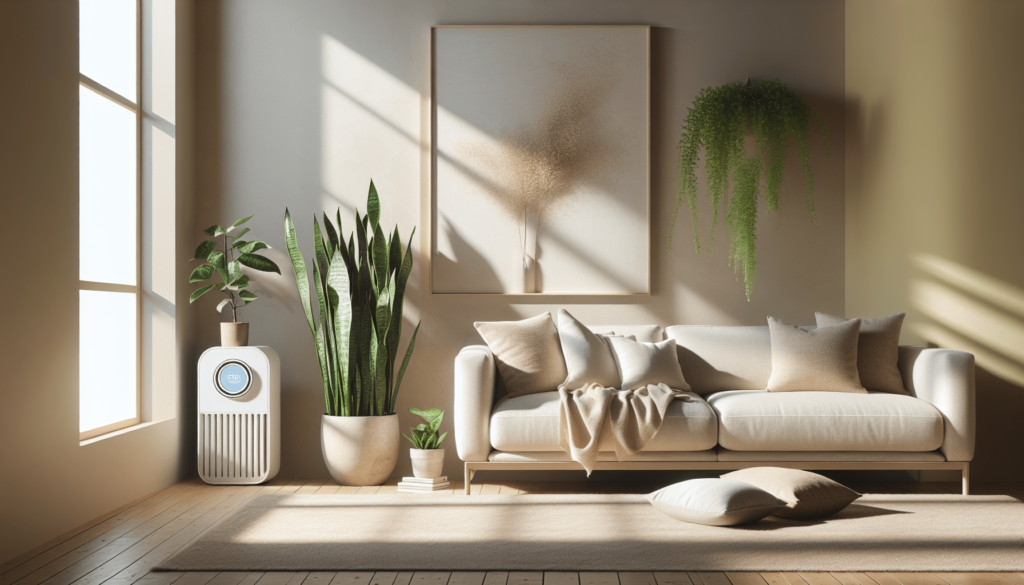Have you ever wondered why you can’t fully relax in your living room, sneezing and coughing despite your best efforts to keep it clean? If this sounds familiar, you’re not alone. Many people suffer from allergies triggered by common elements found right in the comfort of their living rooms. Understanding how to transform your space into an allergy-free sanctuary can bring lasting comfort and improve your quality of life.
Understanding the Sources of Allergens
Before making any changes, it’s essential to identify the common sources of allergens in your living room. By understanding these sources, you can effectively target them and make your living space more comfortable.
Dust Mites
Dust mites are tiny creatures that thrive in warm and humid environments. They feed on dead skin cells and are often found in household dust. These tiny pests can cause or exacerbate allergies, leading to symptoms such as sneezing, runny nose, and itchy eyes.
Pet Dander
Your furry companions may be cherished family members, but they can also be a source of allergens. Pet dander consists of tiny, even microscopic, flecks of skin shed by cats, dogs, and other animals with fur or feathers. They can set off allergy symptoms in sensitive individuals.
Mold and Mildew
Mold spores are a well-known allergen, and the conditions in a living room can sometimes promote their growth. Mold thrives in damp, humid environments and can grow on different surfaces, including walls, windowsills, and furniture.
Pollen
Pollen is not only an outdoor issue. It can easily enter your living room through open windows or doors and even cling to your clothing and pet’s fur, causing allergic reactions.
Common Chemicals
Certain cleaning agents, air fresheners, or personal care products release volatile organic compounds (VOCs) or other allergens into the air, which could trigger allergic reactions in some people.
Reducing Allergens in Your Living Room
Now that you know the culprits, it’s time to look at practical solutions to reduce these allergens in your living room and create a healthier environment.
Choose the Right Flooring
Carpeting can house dust, dust mites, and pet dander, aggravating allergies. Opt for hard flooring such as wood, tile, or vinyl, which is easier to clean and less likely to harbor allergens.
Flooring Options Comparison
| Flooring Type | Pros | Cons |
|---|---|---|
| Hardwood | Easy to clean, durable | Can be costly |
| Tile | Hypoallergenic, water-resistant | Cold and hard underfoot |
| Vinyl | Affordable, easy installation | May contain chemicals |
| Carpet | Comfortable, insulates sound | Traps allergens, harder to clean |
Use Hypoallergenic Furnishings
When selecting furniture, consider hypoallergenic options. Leather and vinyl are easier to wipe clean than upholstery, which can trap allergens. If you prefer fabric furniture, choose tightly woven materials, and use washable covers.
Control Humidity Levels
Maintaining an ideal humidity level in your living room can prevent mold growth and reduce dust mites. Aim for a relative humidity level of 30-50%. Use a dehumidifier or humidifier as necessary, and ensure your home is well-ventilated.
Invest in Quality Air Purifiers
Air purifiers can effectively reduce airborne allergens. Look for models with HEPA filters, which are designed to trap tiny particles such as dust, pollen, and pet dander. For optimal results, place the air purifier in an area of high airflow.
Regular Cleaning and Maintenance
Develop a regular cleaning routine to keep allergens at bay. Vacuum regularly with a cleaner equipped with a HEPA filter. Dust using microfiber cloths that trap dust instead of just moving it around. Remember to wash curtains and clean windows regularly to reduce the buildup of dust and mold.
Adopt Pet-Friendly Practices
If you have pets, there are steps you can take to reduce allergens without giving up your furry friends. Bathe them regularly, brush their fur outside, and restrict them from furniture if possible. Consider setting up a pet-free zone in your living room to minimize dander.

Incorporating Allergy-Friendly Decor
Decorating with health in mind might sound challenging, but thoughtful choices can greatly enhance the allergy-friendly environment of your living room.
Hypoallergenic Plants
While indoor plants can improve air quality, some may release pollen or spores that trigger allergies. Opt for hypoallergenic plants like peace lilies, spider plants, or bamboo palms, which are less likely to cause issues.
Avoid Clutter
Keep your living room tidy to reduce dust accumulation. Store items in closed cupboards instead of open shelves, which can collect dust. Minimalist decor not only facilitates cleaning but is also aesthetically pleasing.
Use Allergen-Proof Covers
Cover pillows, mattresses, and sofas with allergen-proof covers that can prevent dust mites and dander from settling and multiplying. Choose covers made from breathable materials to maintain comfort while ensuring protection.
Smart Lifestyle Changes
Creating an allergy-free living room is not just about the items you choose or cleaning habits—it’s about integrating specific lifestyle adjustments.
Implement a No-Shoe Policy
Shoes can track in a multitude of allergens like pollen, dirt, and chemicals from the outside. Encourage family and guests to remove their shoes when entering to keep your living space cleaner and allergen-free.
Embrace Seasonal Deep Cleaning
In addition to regular cleaning, perform a deep clean of your living room at least once every season. This involves cleaning areas that are not part of your daily routine, such as washing cushions, deep cleaning carpets, and decluttering.
Choose Low-Volatile Organic Compound (VOC) Products
Opt for low- or no-VOC paints, varnishes, and cleaning supplies. These products emit fewer harmful chemicals, making them safer for individuals with allergies.
Regularly Check for Mold
Make a habit of inspecting your living room for signs of mold. Pay attention to areas behind furniture or near windows and doors, where moisture can accumulate. If discovered, clean immediately with an appropriate cleaner and remedy the source of moisture to prevent recurrence.

Long-term Benefits of an Allergy-Free Living Room
Creating an allergy-free living room is more than just eliminating sneezes and sniffles. It fosters a healthier living space, improving overall well-being.
Enhanced Comfort and Health
Without constant exposure to allergens, you can enjoy a more comfortable and healthier living environment. This leads to improved respiratory health and quality sleep, particularly beneficial for those with pre-existing respiratory conditions.
Increased Durability of Home Items
Allergy-resistant items and regular cleaning routines can prolong the lifespan of your furniture and decor. Mites and mold are not only health risks but can also damage materials, leading to the need for replacements.
Improved Cognitive Function
Reducing allergens can lead to fewer health disturbances, meaning fewer days feeling unwell or sluggish due to allergies. This helps improve work focus, overall productivity, and a better lifestyle.
By incorporating these changes, you are on the path to a cleaner, healthier, and more enjoyable living room. Understanding how each step affects your well-being empowers you to make informed choices, ensuring a safe sanctuary free from the nuisances of everyday allergies.
